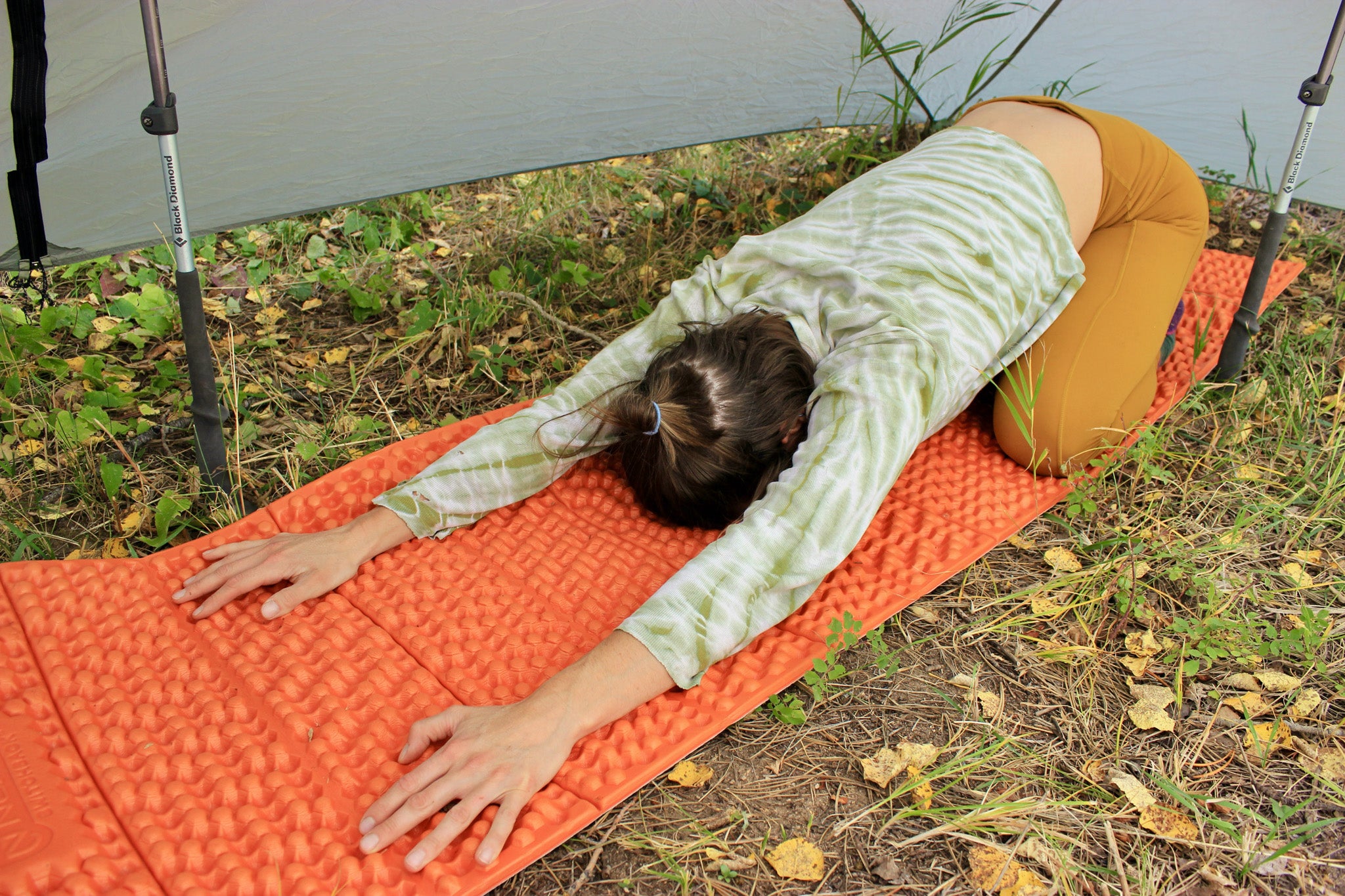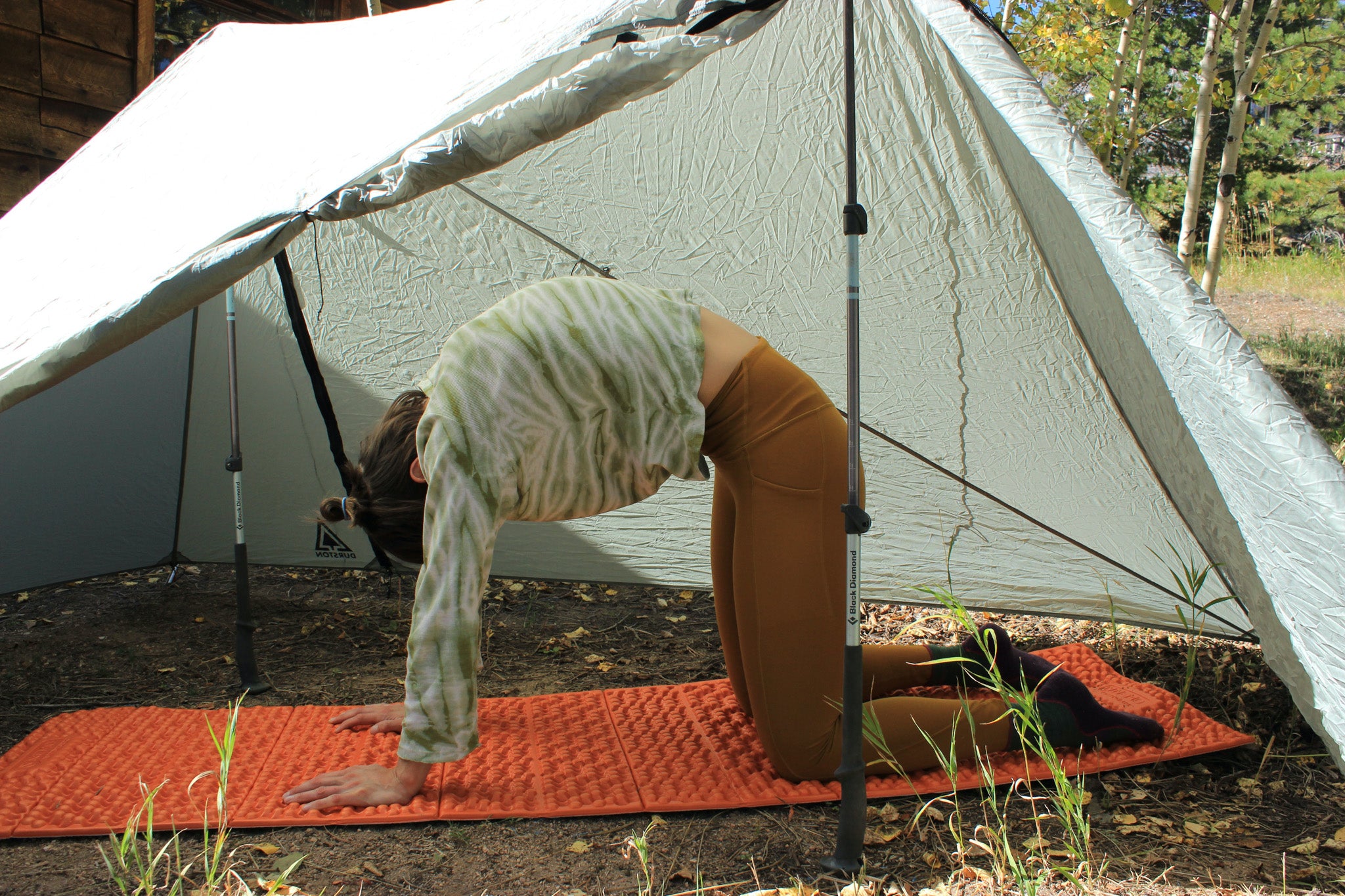
Hiking, backpacking, and especially thru-hiking are stressful activities for our bodies. To hike 8 to 12 hours a day over uneven terrain with thousands of feet of elevation gain while carrying a heavy pack is a lot to ask of our bodies. For thru-hikers who repeat this day after day for months on end, it can wreak havoc.
There’s a wide variety of yoga poses that can be done right in your 1-person backpacking tent. I like having a yoga routine that I can do in my tent for privacy, to escape the elements, or if I just get into camp late and want the comfort and security of my shelter. You can do these yoga poses right on the floor of your tent, or better yet on your foam pad if you carry one.
Here are 5 poses that you can add into your nightly or morning routine to help relieve the stress put on your body from thru-hiking … so you can go the distance!
Extended Child’s Pose (Prasarita Balasana)

Begin on all fours with your knees spread as wide as your mat and your two big toes touching. Hands shoulder width apart. Slowly sink your bum back and down until it touches (or comes close to touching) your heels. Reach your hands out in front and let your forehead come to the earth. Firmly grip the ground with your fingertips and don’t forget to breathe. Extend with your inhale, reaching out a little further with your hands, and sink a little deeper with each exhale.
This pose is a hip opener and a shoulder opener. It can also help stretch out the muscles along the entire length of the back. This pose gives our shoulders the love they need after carrying a heavy pack all day long.
Cat Cow (Bitilasana Marjaryasana)

Position yourself on all fours with your hands directly beneath your shoulders and your knees directly beneath your hips. Toes can be tucked or untucked. Actively push away from your mat with your hands and create a straight line from the crown of your head to your tailbone.
On an inhale, drop your belly down and shine your heart forward. Continue pushing away with your hands and send your gaze forward but be careful not to crunch your neck. You should feel a nice stretch in your abdomen and chest. This is cow pose.

From here transition to cat pose on an exhale. Start by tucking your tailbone underneath you. Continue up the back, one vertebrae at a time, arching your spine up toward the sky. When you finally reach your neck, let the weight of your head relax. Continue to actively push away from your mat with your hands. Your shoulder blade area should be in a dome shape and you should feel a nice stretch in the upper back.
From here, you can transition back to cow pose on an inhale. Always start the transition in your tailbone and work your way up.
Cat cow is going to offer you some much needed spinal flexion to keep your back healthy after the pounding it takes from long descents.
Reclined Pigeon (Supta Kapotasana)

Begin this pose by laying flat on your back with the soles of your feet touching the ground. Try to draw your navel downward and get your lower back as flat against the ground as possible. Bring your right foot up and place the outside of your right ankle on your left thigh. Keep your right toes flexed the whole time. Then, reach through and grab your left hamstring with both hands. Pull your left thigh toward you until your left shin is parallel to the earth. Your right elbow can rest against the inside of your right thigh.
You should begin to feel a stretch in the outside of your right thigh. The more you pull your leg with your hands, the deeper of a stretch you’ll feel. Stay here for a few full breaths, and then release everything on an exhale with control. Repeat on the opposite side.
As someone who suffers from IT band pain, this is one of my must-do stretches every single morning and night (and often multiple times throughout the day). Reclined pigeon will help keep your knees healthy and your IT band feeling nice and loose.
Seated Forward Fold (Pashchimottanasana)

Sit on the ground with your back straight and your feet out in front. Create as much bend in your knees as you need because we’re aiming for a stretch in the lower back. Inhale and reach up toward the sky with your hands while creating length through your spine, all the way up to the crown of your head. On an exhale, lead with your chest as you keep your back straight and bend at the waist. Your hands can grab the soles of your feet, the calves, or even the backs of your thighs. Relax the weight of your head down and stay here for a few breathes. You should feel a deep stretch in your lower back. If you want to feel it more in your hamstrings, straighten out your legs a bit.
We really can’t take care of our backs enough, and this one targets the lower back just above the hips. It also can provide a nice bonus stretch in the hamstrings!
Downward Facing Dog (Adho Mukha Shvanasana)

This is a big one, probably the most active stretch we’ll talk about here. I like to start downward dog on all fours. Place your hands underneath your shoulders and put your knees under your hips with toes tucked. Now sink your butt back into space, firmly plant your hands, and then raise your hips up high and sink your heart down and back. You should have a slight bend in your knees, and direct your focus on extending your hips upward. Continue to grip and push away with your hands, and drive your heels toward the earth. They don’t have to touch.
This is a full body stretch that you’ll feel all the way through your calves, hamstrings, back and shoulders. Remember to breathe. When you’re ready to release, slowly bring your knees back to the ground and return to all fours.
Parting Thoughts
I sincerely hope these yoga poses offer your body and mind some relief from the constant beating it takes out there on the trail. I find that I’m much more likely to take care of myself if it’s something that can be done from the privacy of my own tent. In fact, I used to be a hammock camper and then switched to a tent specifically so I could do my stretches no matter the weather or how crowded the camping area. I love sleeping in my hammock, but I found that I would usually just plop into bed for the comfort and privacy of my shelter. Now that I have a simple and nourishing yoga routine, thru-hiking is significantly more enjoyable and less painful. I hope this brings more enjoyment to your hiking life as well. Namaste.














1 comment
MaryR
Thank you. This looks like this routine will help me.